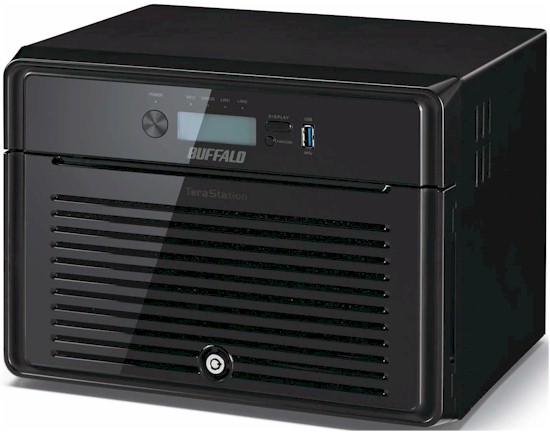
| At a glance | |
|---|---|
| Product | Buffalo Technology TeraStation 5800 (TS5800D1608) [Website] |
| Summary | Eight-drive Intel D2700 Atom business NAS running revamped Buffalo Linux-based OS |
| Pros | • Dual Gigabit Ethernet • Three USB 3.0 ports |
| Cons | • Still doesn’t support rsync to non-Buffalo products |
Typical Price: $1803 Buy From Amazon
Introduction
Updated 7/1/2013 – Added link to OS review
Buffalo has retired its TeraStation Pro line and replaced it with the new TeraStation 5000 series. The new platform comes in variations sporting from two to eight drives in desktop and rackmount versions.
All are powered by either 1.86 GHz Intel D2550 or 2.13 GHz D2700 dual-core Atom processors with 2 GB of DDR3 RAM. As the table below shows, all also have both USB 2.0 and USB 3.0 ports, but no eSATA. Buffalo sent the top-of-line 5800 for review, so let’s get started.
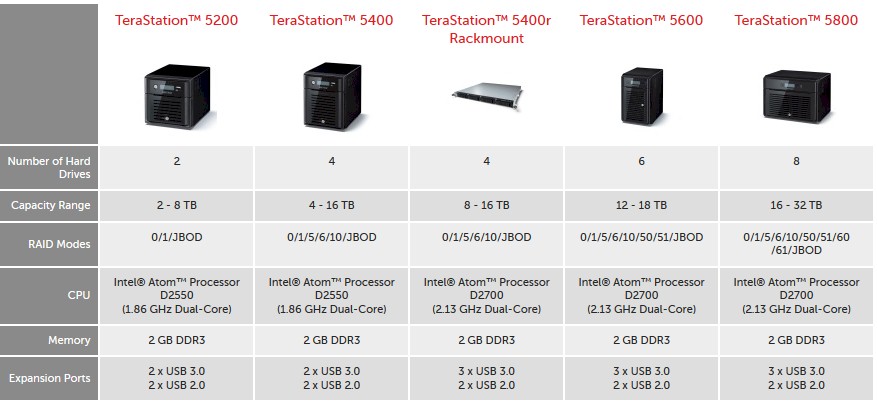
Buffalo TeraStation Product Families
Bufalo has opted for a lockable front panel, that can be completely removed to expose the eight hot-swappable 3.5" SATA drive bays.
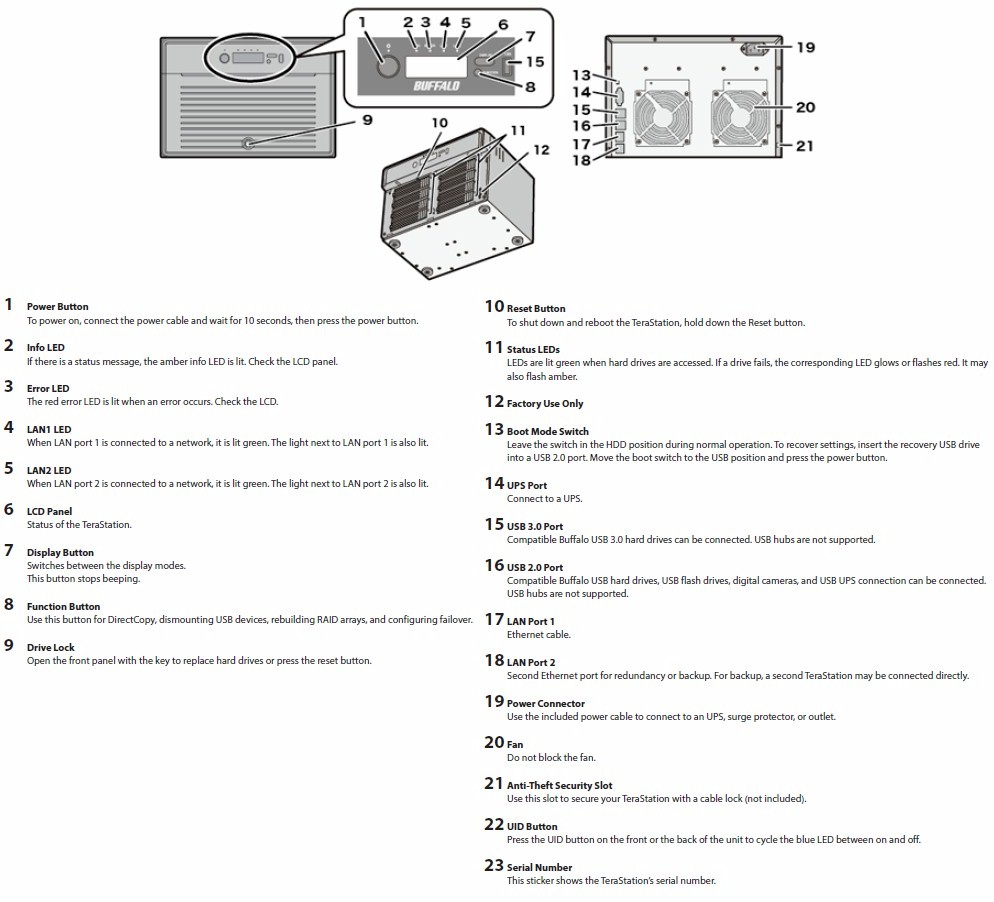
Front and rear panels
That #12 Factory Use Only port behind the front door is a standard VGA port. So when you connect a monitor and USB keyboard mouse, you can just fire up a server console and have at it. Buffalo still includes a serial port for syncing with UPSes that use that connection method. Note the Boot Mode switch (13) that allows for booting from a USB recovery drive.
Inside
The 5800 is designed for moderately easy serviceability. The two fans are on panels and can be changed without removing the cover. Once the cover is off, you can get right at the power supply and regulator boards.
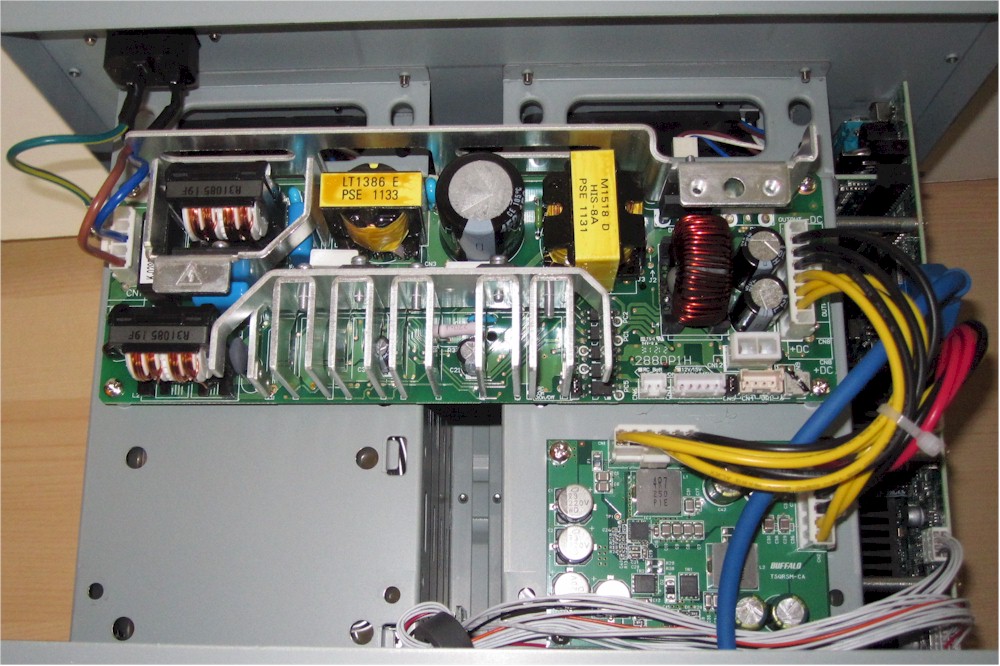
Buffalo TeraStation 5800 inside top view
The board is mounted on the side and plugs right into the drive backplane. Removing the main board requires taking off the back cover.
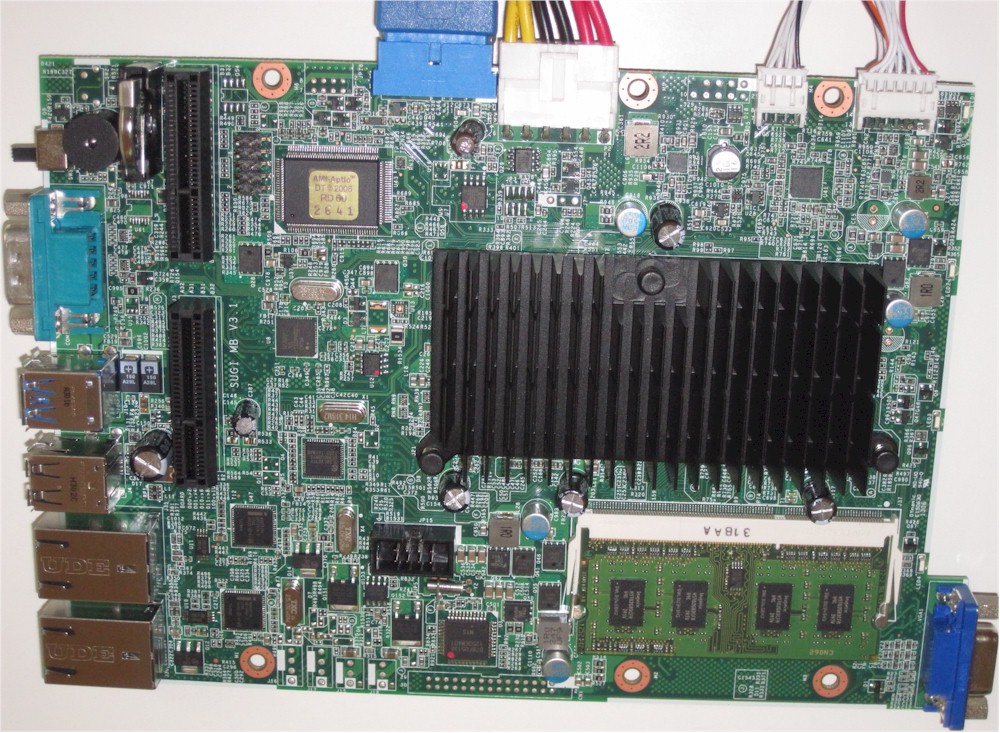
Buffalo TeraStation 5800 board
The 5800’s board (above) bears a strong resemblance to the TeraStation Pro Quad‘s board (below). But they are different boards.
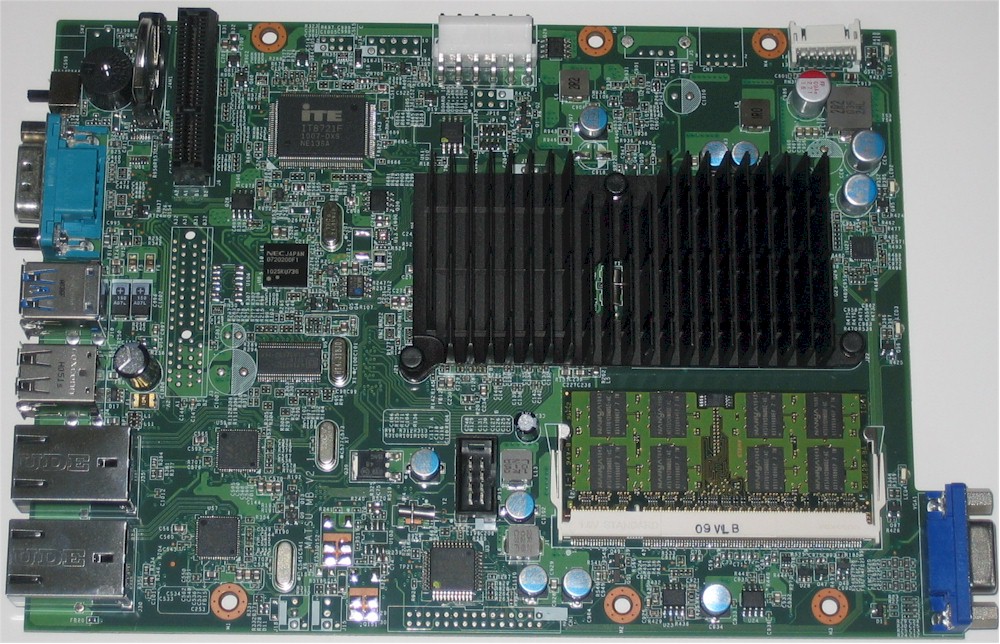
Buffalo Pro Quad board
The key components of both are summarized and compared in Table 1.
| Component | TeraStation 5800 | TeraStation Pro Quad |
|---|---|---|
| CPU | Intel D2700 Atom @ 2.13 GHz | Intel D510 Atom w/ Intel 82801IR I/O Controller |
| RAM | 2 GB | 2 GB |
| Flash | None | 2 MB |
| Ethernet | Intel WG82574L Gigabit Ethernet Controller (x2) | Marvell 88E8059 Yukon PCI-e Gigabit Ethernet controllers (x2) |
| SATA | In Intel companion device | In Intel companion device |
| USB 3.0 | NEC D720201 | NEC D720200F |
| Microcontroller | NEC D78F0513A | NEC D78F0513A |
| I/O | ITE IT8721F | ITE IT8721F |
Table 1: Key component summary and comparison
The review unit came with eight Seagate Barracuda 2 TB (ST2000DXM001) drives installed, which brought the total power consumption to 79 W. There is no idle drive spindown feature, but you can program three sleep / wake schedules to save some power.
The system was relatively quiet for an eight-drive NAS. The fans ramp up to full speed during boot, but then settle down after the system is fully up. I rated total noise as medium. Definitely audible, but not annoyingly so in my quiet home office.
Features
What’s better to go with new hardware than a new look for your admin interface? Since admin GUI makeovers seem to be all the rage with NAS manufacturers these days, Buffalo decided to not be left out. They didn’t give their new look a flashy new name, though. You can get a feel for the new look from the screenshot below.
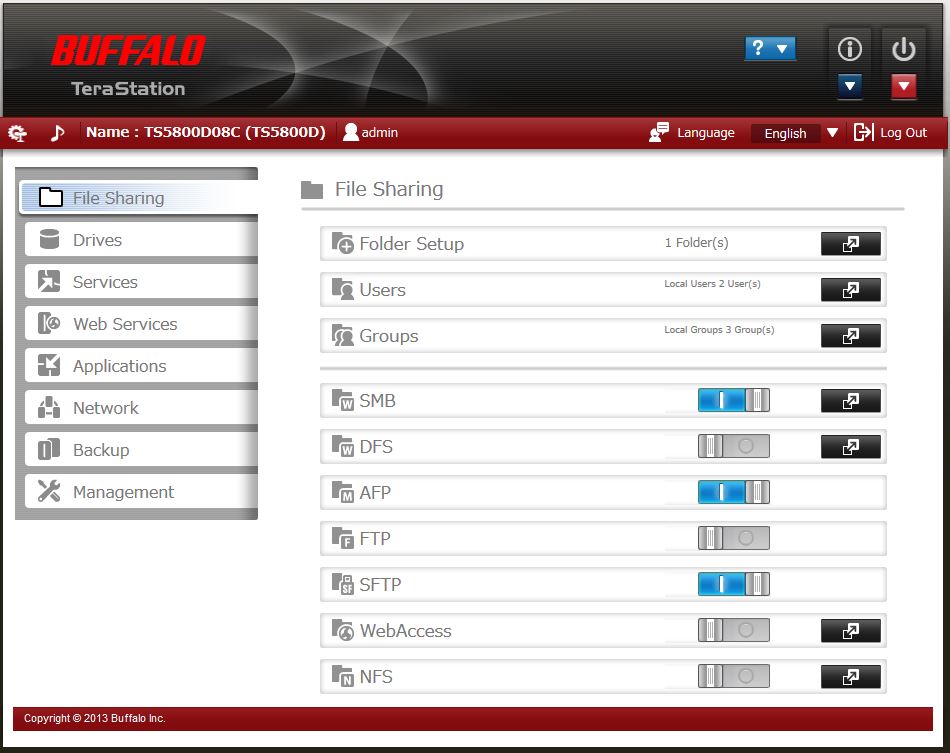
Buffalo TeraStation 5800 Admin GUI
Updated 7/1/2013
It’s been such a long time since we took more than a glance at Buffalo’s features. So I’ve asked Craig to do a full review.
My two cents is that I like the new look, but it feels like a more attractive layer bolted on top of the old system. Every function you click on opens a smaller window where the controls you actually want are contained. Felt like a lot of unnecessary clicking to me.
Performance
I tested the 5800 with its factory-installed 2.40-1.28 firmware using our NAS test process to run tests with RAID 0, 5 and 10 volumes using four of the eight drives.
The Benchmark Summary below shows the 5800’s fastest performance is with RAID0. But the different files used for the Windows File Copy and Intel NASPT benchmarks produce significantly different results at 97 and 125 MB/s, respectively. The same benchmarks for read swap places, with NASPT slower at 79 MB/s and Windows File Copy faster at 104 MB/s.
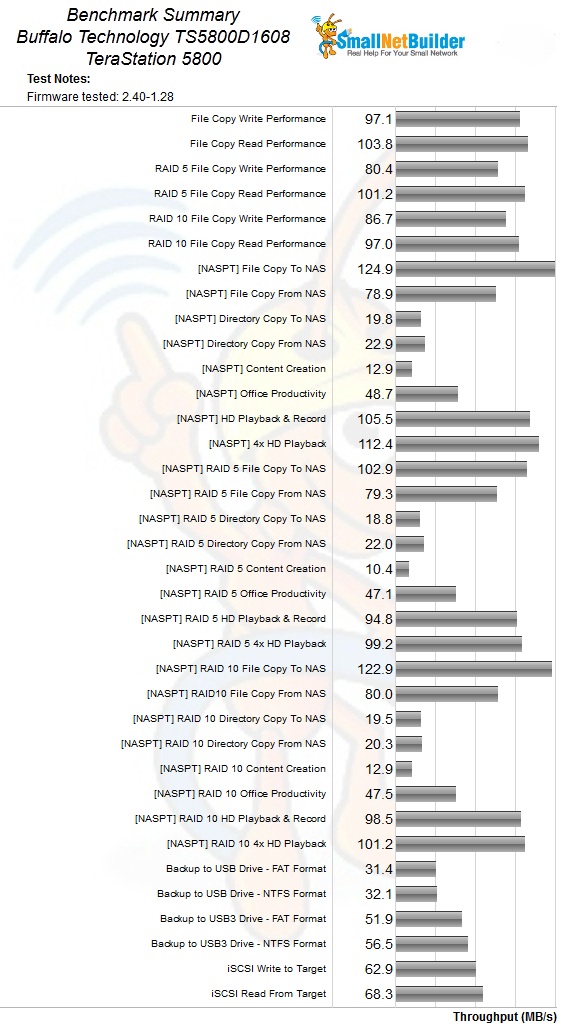
Benchmark Summary
RAID5 and 10 Windows file copy writes are slower than RAID0 by 15 to 20%, while read penalty is negligible. The equivalent NASPT large file copy writes tests show RAID0 and 10 throughput about equal and maxing out the Gigabit Etherent connection bandwith at 120+ MB/s. NASPT Reads for all three volume types are about equal at 80 MB/s.
iSCSI target performance to a target created on a RAID 5 volume didn’t set any records at a relatively poky 63 MB/s write and 68 MB/s read. Best-in-class products in this processor class can write at 100 MB/s and read at around 90.
Your best option for attached backup is USB 3.0 with an NTFS formatted drive. But you’ll get only in the mid-50 MB/s copy rate. In contrast, Atom-based QNAPs yield over 110 MB/s for the same test. I couldn’t run a network backup test because Buffalo stubbornly refuses to support anything other than its own NASes for that.
Although it has steadily improved, Buffalo’s performance has tended to lag behind its competition. It looks like the 5800 continues that tradition. I compared the only other two eight or more bay D2700 Atom based NASes we’ve tested, the QNAP TS-869 Pro and Thecus N7510. The summary below shows that the QNAP is the most consistently best performer of the bunch. The 5800 comes in at the bottom of the ranking for three of the four benchmarks.

RAID 5 File Copy Performance comparison
Closing Thoughts
Buffalo continues to close the gap on its competition and the 5800 is another step in that direction. But the company still doesn’t seem to have the seem feel for performance tuning that its Taiwanese competition does.
It does have a good feel for value, though. 16 TB of Buffalo storage in the 5800 will run you around $1500. Getting the same storage in the top-performing QNAP TS-869 will run you around $1100 for the chassis and $800 for eight 2 TB drives.
Before you make your final decision, however, check to see if you like its new admin GUI.
